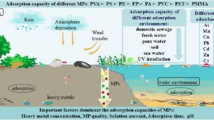Abstract
The complexation capacity of Cu and Pb and their labile and organic contents were determined separately for surface seawater samples from Yueqing Bay. The samples were prepared using Nuclepore filtration method yielding <1.0 μ, <0.4μm and <0.2μm particulate water samples. Our data indicated that the <0.2μm colloidal fraction is a major carrier for distribution of copper in seawater. Affinity of Cu to marine microparticles plays an important role in the process. Pb however, tends to be absorbed by >0.2μm particles. The complexation capacity of Pb with <0.2μm particulates was smaller than that with 0.2–1.0μm particulates, and averaged 11.5 and 23.0nmol/L respectively. The results suggested that colloidal particles were responsible for the distribution and concentration of Pb in seawater.
Similar content being viewed by others
References
Batley, G. E., T. M. Florence, 1976. Determination of the chemical forms of dissolved Cadmium, Lead and Copper in seawater.Mar. Chem. 4: 347–363.
Florence, T. M., 1998. Evaluation of some physico-chemical techniques for the determination of the fraction of dissolved copper toxic to the marine diatom.Nitzschia closteriμm. Anal. Chim. Mota. 151: 281–29.
Gu, H. K., 1991. Marine Chemistry in Bohai Sea, Huanghai Sea and East China Sea. Science Press. Beijing, China, 245–266. (in Chinese)
Guo, L., 1996. Cycling of high molecular weight dissolved organic matter in Middle Atlantic Bight.Limnol. Oceanogr. 41: 1242–1252.
Guo, L., 1998. The distribution of colloidal and dissolved organic carbon in the Gulf of Mexico.Mar. Chem. 45: 105–119.
James, P., and A. Meador, 1998. Copper tolerance by the freshwater algal speciesOocystis pusilla and its ability to alter free-ion copper.Aquatic Toxicology 44: 69–82.
Koiko, L., 1990. Role of sub-micrometre particles in the ocean.Nature.345: 242–244.
Martin, J. M., M. H. Dai, G. Cauwet, 1995. Significance of colloids in the biogeochemical cycling of organic carbon and trace metals in a coastal environment-example of the Venice Lagoon (Italy).Limnol Oceanogr 40: 119–131.
Mackey, D. J., 1983. The strong complexing capacity of sea-water—an investigation of south-eastern Australian coastal water.Mar. Chem. 14: 73–87.
Shiller, A. M., E. A. Boyle, 1987. Variability of dissolved metals in the Mississipi River.Geochem. cosmichem. 51: 3273–3277.
Wells, M. L., 1991. Occurrence of small colloids in seawater.Nature.353:342–344.
Wells, M. L., 1998a. Marine sub-micron particles.Mar. Chem. 40: 5–18.
Wells, M. L., 1998b. Marine colloids, A neglected dimension.Nature 391: 530–531.
Wells, M. L., P. B. Kozelka, K. W. Bruland, 1998. The complexation of ‘dissolved’ Cu, Zn, Cd and Pb by soluble and colloidal organic matter in Narragansett Bay.Mar. Chem. 62: 203–217.
Author information
Authors and Affiliations
Additional information
Project No. 40076025 supported by the NSFC.
Rights and permissions
About this article
Cite this article
Zhengfang, W., Haiyan, L. & Hefang, F. Measurement of labile Cu, Pb and their complexation capacity in Yueqing Bay in Zhejiang Province, China. Chin. J. Ocean. Limnol. 22, 64–69 (2004). https://doi.org/10.1007/BF02842802
Received:
Accepted:
Issue Date:
DOI: https://doi.org/10.1007/BF02842802




